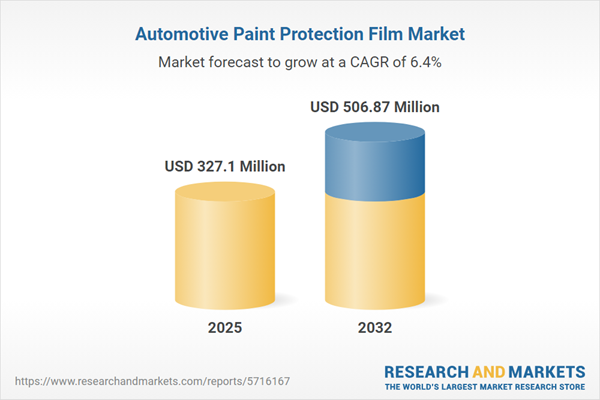Speak directly to the analyst to clarify any post sales queries you may have.
The automotive paint protection film market is evolving rapidly as industry stakeholders look for advanced solutions to preserve vehicle aesthetics and performance. Enhanced formulations, shifting consumer expectations, and regulatory dynamics are shaping both innovation and competitive strategy in this specialized segment.
Market Snapshot: Automotive Paint Protection Film Market Size and Growth
The Automotive Paint Protection Film Market grew from USD 308.09 million in 2024 to USD 327.10 million in 2025. It is expected to continue growing at a CAGR of 6.42%, reaching USD 506.87 million by 2032. This sustained upward trajectory reflects robust demand from original equipment manufacturers, the aftermarket, and an expanding base of commercial and premium vehicle owners. Market growth is supported by rising awareness of long-term vehicle appearance, value retention, and advances in self-healing technology. Increasing adoption in emerging regions further underscores the evolving opportunities for supply chain participants and installers alike.
Scope & Segmentation
The report delivers a granular analysis across multiple dimensions:
- Product Types: Non-healing films including polyester and polypropylene; self-healing technologies incorporating acrylic adhesive, nano-coated, polyvinyl chloride, and thermoplastic polyurethane variants.
- Finish Options: High-gloss, semi-gloss, glossy matte, satin matte, and textured matte for aesthetic and functional versatility.
- Material Types: Aliphatic and aromatic thermoplastic polyurethane, polyvinyl chloride, and recyclable vinyl tailored for elasticity, resilience, and sustainability.
- Adhesive Technologies: Permanent and removable acrylic, silicone, and urea derivative adhesives for varied application and removal requirements.
- Application Methods: Heat fusion, static cling dry, as well as spray and squeegee wet installation techniques to optimize workflow and conformability.
- End Uses: Commercial fleets seeking durability and easy maintenance; personal vehicles prioritizing aesthetics and convenient repair.
- Sales Channels: Direct sales through manufacturers or retailers; online routes via automaker websites and broader e-commerce platforms.
- Vehicle Categories: Coverage for construction semi-trailers, long-haul trucks, mini trucks, vans, hatchbacks, sedans, and SUVs.
- Regions: Comprehensive insights are provided for Americas (with coverage of North America and Latin America sub-regions), Europe, Middle East and Africa, as well as Asia-Pacific—including detailed breakdown for key countries within each region.
- Companies Profiled: In-depth trends, strategies, and developments across leading participants such as 3M Company, Avery Dennison Corporation, BASF SE, Eastman Chemical Company, XPEL, and additional established and emerging market players.
Key Takeaways
- Adoption of advanced self-healing polymer technologies is shifting industry standards, meeting client expectations for resilience and minimal visible wear.
- Finish customization—ranging from high-definition gloss to durable matte—caters to luxury vehicle owners as well as commercial clients prioritizing branding and fleet consistency.
- Material innovation, especially in recyclable films and environmentally responsible adhesives, is gaining momentum to support global sustainability mandates.
- Integration with automated installation systems, advanced cutting platforms, and digital imaging is streamlining deployment, elevating installer productivity, and reducing waste.
- Strategic partnerships with original equipment manufacturers and fleet managers are expanding market access and facilitating factory-fitted film solutions.
- Diversified sales channels and vertical integration efforts are helping stakeholders buffer supply chain risks while optimizing cost controls.
Tariff Impact: Navigating U.S. Duty Adjustments
Recent U.S. tariff adjustments have transformed global paint protection film trade flows and pricing. Manufacturers are shifting sourcing to North America and Mexico, promoting nearshore manufacturing and regional supply alignment. Downstream adaptation includes contract renegotiation by installers and increased local production investments, which bolster supply resilience but may raise capital requirements. These shifts are driving a stronger supply chain infrastructure and giving competitive advantage to firms proactive in their response.
Methodology & Data Sources
This market analysis employs a multi-step methodology: comprehensive desk research of technical publications, regulatory databases, and material journals; primary interviews with polymer scientists, manufacturers, and end users; and direct facility and service center visits. Secondary validation incorporates competitive analysis from company disclosures and real-time import-export data to ensure acute accuracy and actionable intelligence.
Why This Report Matters
- Enables senior decision-makers to identify technology trends and market forces driving purchasing decisions in automotive paint protection films.
- Supports risk-managed expansion by clarifying the impact of regulatory updates and tariff changes on supply chains and sourcing.
- Equips product, procurement, and strategic planning teams with validated intelligence for regional entry, channel development, and innovation roadmaps.
Conclusion
The evolving automotive paint protection film market demands agile responses from manufacturers, suppliers, and service providers. Strategic alignment with emerging material technologies, installation efficiencies, and region-specific compliance will enable sustained growth and competitive positioning for industry leaders.
Additional Product Information:
- Purchase of this report includes 1 year online access with quarterly updates.
- This report can be updated on request. Please contact our Customer Experience team using the Ask a Question widget on our website.
Table of Contents
3. Executive Summary
4. Market Overview
7. Cumulative Impact of Artificial Intelligence 2025
Companies Mentioned
The companies profiled in this Automotive Paint Protection Film market report include:- 3M Company
- Armordillo Surface Protection Film
- Avery Dennison Corporation
- BASF SE
- Bluegrass Protective Films LLC
- Covestro AG
- Eastman Chemical Company
- Garware Hi-Tech Films Limited
- HEXIS S.A.S
- ORAFOL Europe GmbH
- Reedee Co. Ltd.
- RENOLIT SE
- Saint-Gobain Group
- Schweitzer-Mauduit International, Inc.
- XPEL, Inc.
Table Information
| Report Attribute | Details |
|---|---|
| No. of Pages | 195 |
| Published | November 2025 |
| Forecast Period | 2025 - 2032 |
| Estimated Market Value ( USD | $ 327.1 Million |
| Forecasted Market Value ( USD | $ 506.87 Million |
| Compound Annual Growth Rate | 6.4% |
| Regions Covered | Global |
| No. of Companies Mentioned | 16 |









